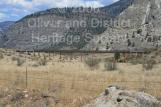14
Photograph of flume showing newer anti-corrosion steel24 July 2008
Oliver, British Columbia, Canada
 Credits:
Credits:Sabyan, Gregory
15
The Okanagan is a one-of-a-kind ecosystem in Canada. Sagebrush and antelope brush create low-lying habitats and forage for desert mice and snakes. Bunchgrass and cacti grow in patches, and a cryptobiotic crust help to lock moisture and nutrients into the soil and provides additional habitat for rare invertebrates and plants. Unfortunately, the pockets of arid landscape which remain undisturbed are small and sparse, so that none are large enough to house a stable ecosystem.Attempts are being made to restore this ecosystem as much as possible, through developing a protected National Park area, and other initiatives.
16
Flume segment in Southern Oliver24 July 2008
Oliver, British Columbia, Canada
 Credits:
Credits:Sabyan, Gregory
17
One factor contributing to the destruction of natural Okangan habitats is the introduction of invasive alien species. These are characterized by plants or animals which are introduced from another habitat and are able to succeed in the new one without significant predation or grazing.The danger of alien species lies in this unregulated growth. Most alien species compete with local species for resources and space, but local species can be overwhelmed by uncontrolled growth of invasive aliens, such as in the case of cheatgrass. Cheatgrass received its name because it chokes out other native grasses, and contains no nutritional value for native fauna. Many of the most invasive species, such as knapweed are superb adapters, and trying to remove them may actually lead to their spreading further. Careful research is required for the best way to deal with invasive species.
Other alien species can threaten local species because of their effect on other parts of the ecosystem. Eurasian Watermilfoil, for example, creates dense mats of plant material which block out sunlight and alter chemical balance in freshwater systems.
18
Examples of invasive weed species in the Oliver AreaCirca 2000-2008
Great Basin Desert Ecosystem
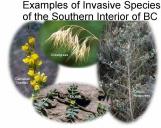 Credits:
Credits:Dalmatian Toadflax, Bob Nowierski, Montana State University, Bugwood.org, www.invasive.org
Cheatgrass, Steve Dewey, Utah State University, Bugwood.org, www.invasive.org
Puncture Vine, Howard F. Schwartz, Colorado State University, Bugwood.org, www.invasive.org
Knapweed, Carey Minteer, University of Georgia, Bugwood.org, www.invasive.org
19
Modern water worries echo the concerns of the Conservative party elected in 1928. Historically, the concern was whether the canal project could generate enough returns to warrant its construction. Today, anxiety lies in wondering how long local reservoirs will be able to sustain our water consumption habits in the face of demographic and climate change.21
Recently, a Food Security Network group was founded in Oliver to address concerns about safety of the food supply in the context of increasing damage to agricultural land. This group has raised the awareness of the fragility of our food supply worldwide, and locally, through sponsored documentary films shown at the local theatre, and through hosted discussion forums.22
Consumption is not the only factor stressing the Okanagan's water supplies; pollutants are having a growing impact on water quality. Toxins such as pesticides, petroleum products, and harsh fertilizers can enter the river, lakes, and reservoirs by groundwater seepage, and storm drains. Damming adds to the problem, as it prevents pollution from being washed downstream, and many chemicals can settle to the bottom where they accumulate, or soak into the ground to contaminate underground aquifers.23
Patullo Damn on southern Vaseaux Lake24 July 2008
Oliver, British Columbia, Canada
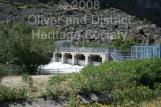 Credits:
Credits:Sabyan, Gregory
24
Unnatural levels of nutrients, such as phosphates and nitrates, as well as organic waste, have an even greater impact. High levels of phosphates and nitrates in water encourages algae blooms. When the nutrient is depleted, the large algae population dies off, and becomes, in essence, more organic waste.Bacteria in the water use oxygen when consuming organic matter. When an algae bloom dies off, or a large amount of organic waste is introduced to the water, the oxygen can be used more quickly than it is replenished, stressing or killing fish. If oxygen levels drop too low for naturally occurring bacteria, they will continue to consume the dead matter by using fermentation, or other elements such as nitrogen or sulphur. Many of the by-products of using oxidants other than oxygen are toxic, and compounded with the stresses of a low-oxygen environment, these poisons can quickly decimate an ecosystem.
25
Algal bloom in oxbow near Haynes Ranch barn.17 July 2006
Oliver, British Columbia, Canada
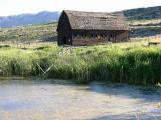 Credits:
Credits:Russell Work
26
With the improvement of architectural and engineering technology, many parts of the canal have been modified or completely replaced to be more efficient. Some segments have been moved underground to better protect them from the elements and rockslides.27
Striations on the rock face near Gallagher Lake show the previous location of the flume.24 July 2008
Oliver, British Columbia, Canada
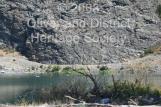 Credits:
Credits:Sabyan, Gregory
